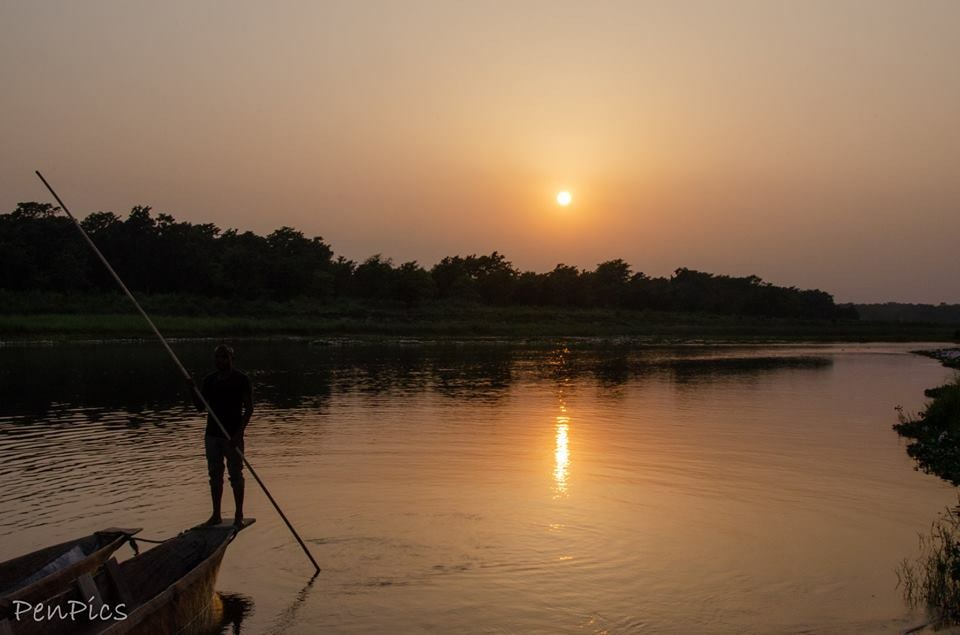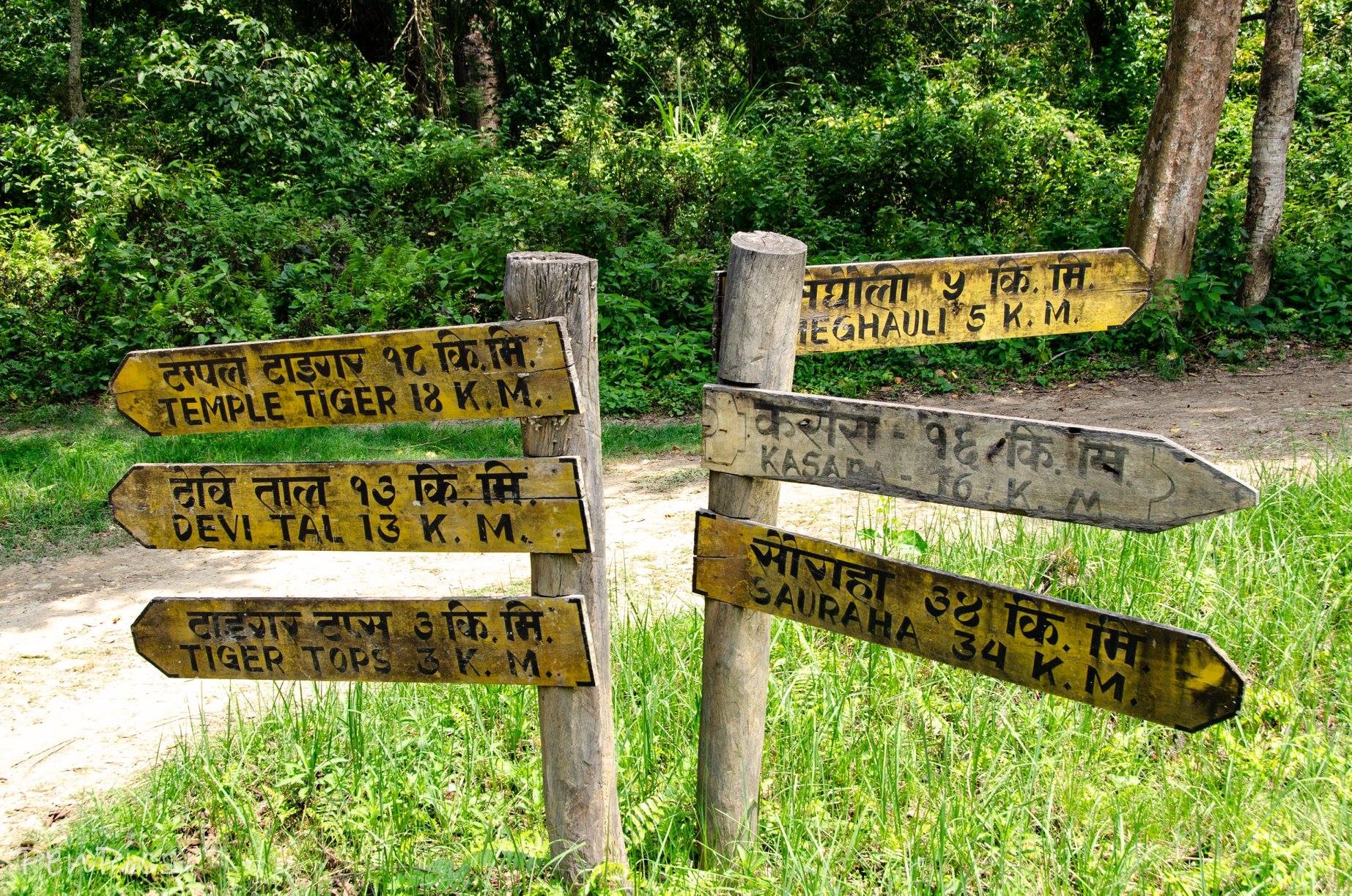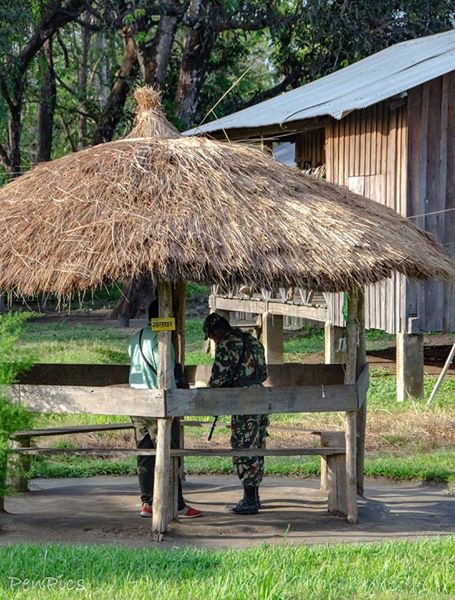“Nepal 🇳🇵Sauraha ~On Safari in Chitwan National Park”
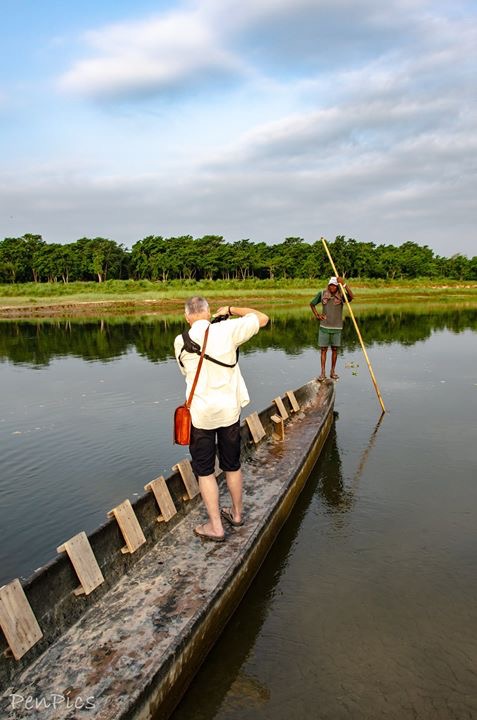
For our Safari in Chitwan National Park, we entered on the Nepal side, from the town of Sauraha. It is from there, the military manages the post, where daily passes must be purchased for entrance into the Park. The military personnel were always late to open, which contributed to the lack of Tiger sightings at the break of dawn.
There are no fenced boundaries on this reserve. The reserve is shared with India, and that would be the only land border crossing. The other borders in Chitwan are all waterways. It is necessary, from the little town of Sauraha, to cross the Rapti River by dugout canoe, to get into the Park, as well as back out.
The small town of Sauraha was a site to see, in itself. Many private owners of working elephants, who are riding them in and around this area, like others would ride bikes. To someone like me, not familiar with the scene, it reminded me of back in old-world America, when the traveling circus came to town, and the parade that ensued; of course minus the elaborate costumes and all.
Daryl and I watched the Ele activity of the town from a lofty restaurant. I will never forget this!
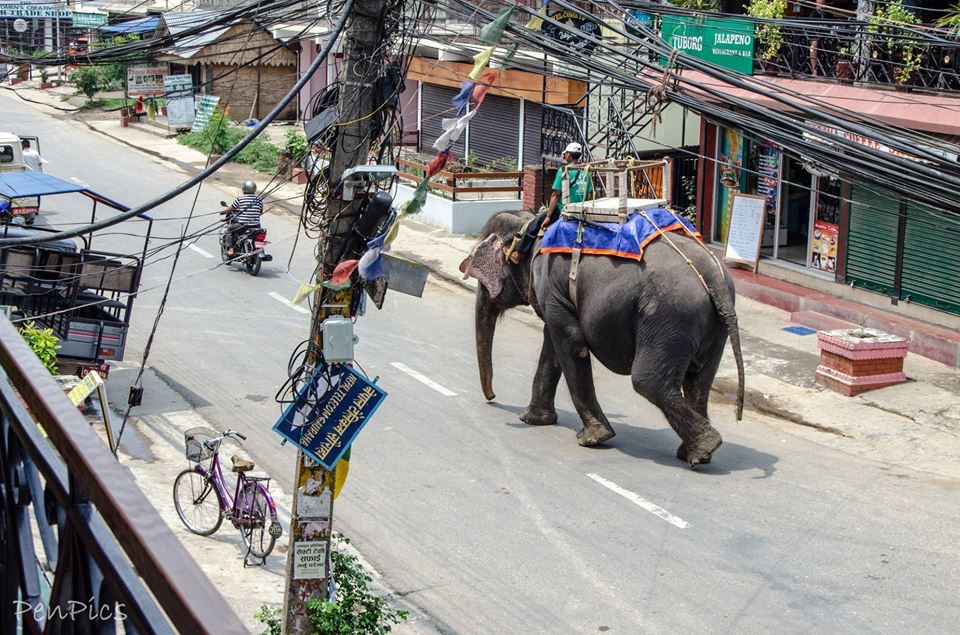
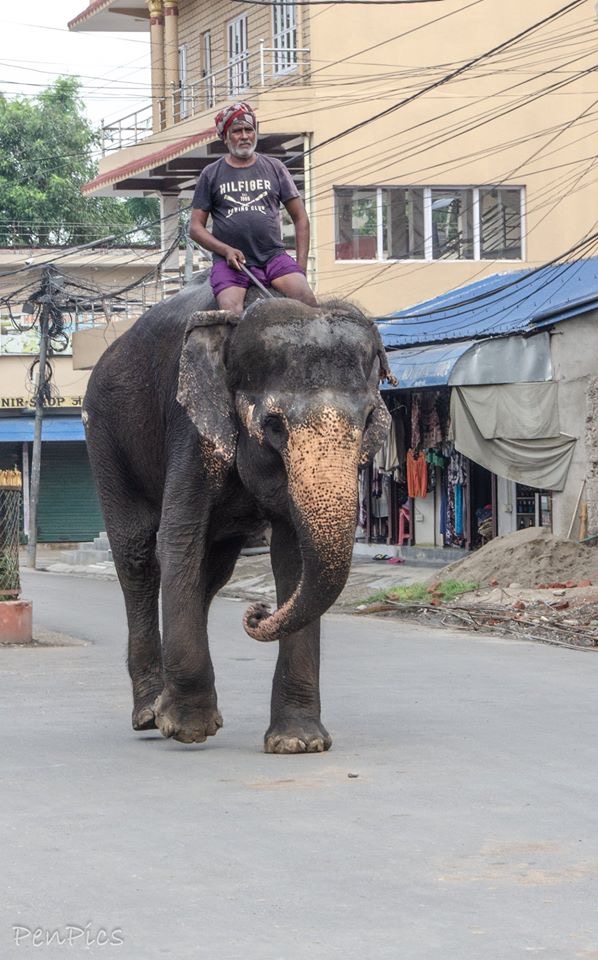
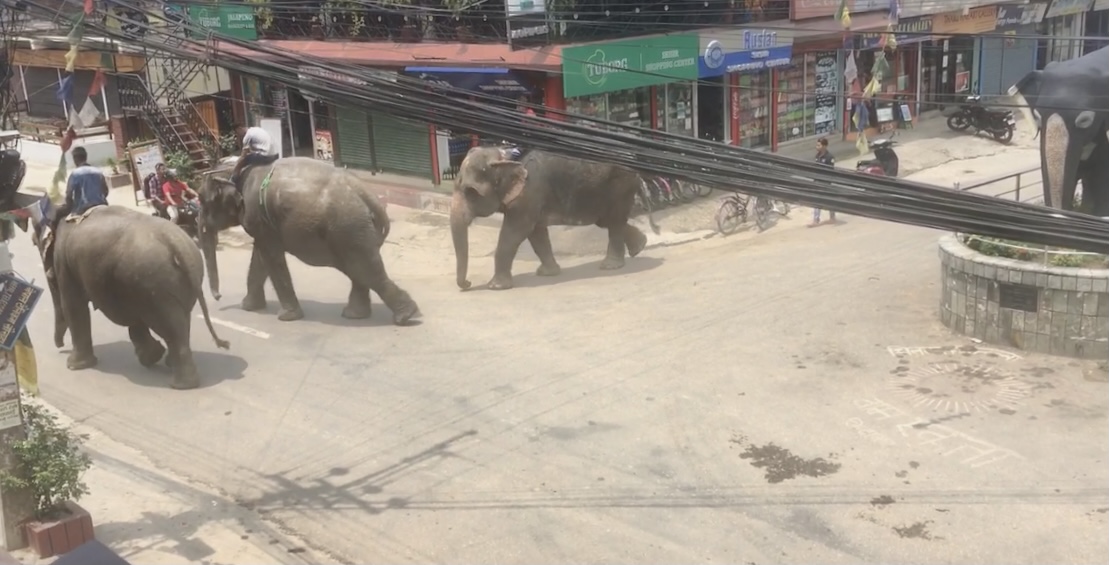
I asked the waiter at the restaurant, who cleans up the streets with all the Elephants walking through.
I was told the shopkeepers do, if the “pile” is in front of their place of business.
“Chitwan National Park,”formerly the Royal Chitwan National Park, is the first National Park in Nepal. It was established in 1973 and granted the status of a World Heritage Site in 1984. It covers an area of 360 sq miles and is located in the subtropical Inner Terai lowlands of south-central Nepal, in the districts of Nawalparasi, Parsa, Chitwan and Makwanpur. In altitude, it ranges from about 330 feet above sea level in the river valleys to 2,674 feet above sea level, in the Churia Hills.
At the foot of the Himalayas, Chitwan extends over the foothills of India and Nepal. It has a particularly rich flora and fauna. One of the last populations of single-horned Asiatic Rhinoceros lives in the Park, which is also one of the last refuges of the Bengal Tiger. NOTE: we do not recommend this reserve if your goal is to spy a Tiger. We tried and never saw any, although we saw plenty of sign they do exist here. BUT, the road access is limited and both wild Tigers and Elephant can be in the foothills where the roads do not go. That being said, Chitwan is a beautiful place to Safari in, and it is one of our all-time favorites! (out of 13 safaris around the world, so far. If you want to see Tigers in the wild, plan your Safari in Bandhavgar Nation park in India! We saw 9 different Tigers and 12 sightings!

⬆️ My photo from Bandhavgar Nation Park Tiger Safari
More History on Chitwan
Royal Chitwan National Park was created in 1973, but the area has been protected since at least the 19th century as a hunting reserve for Nepali and foreign aristocrats. King George V and his son, the young Edward VIII, managed to slaughter a staggering 39 Tigers and 18 Rhinos during just one blood-soaked safari to Chitwan in 1911. But, despite all the toffs, firing buckshot into the jungle, Chitwan’s status as a hunting reserve probably protected more animals than it killed. The biggest threat to wildlife in lowland Nepal has always been habitat loss, and the forest and malarial swamps were preserved to provide cover for game, keeping human encroachment to a minimum. Until the late 1950s, the only inhabitants of the Chitwan Valley were small communities of Tharu villagers, who were blessed with a natural resistance to malaria. After a massive malaria eradication program in 1954, land-hungry peasants from the hills swarmed into the region and huge tracts of the forest were cleared to make space for farmland. As the wildlife habitat disappeared, so did the Tigers and Rhinos. By the mid 1960s, there were fewer than 100 Rhinos and 20 Tigers. News of the dramatic decline reached the ears of King Mahendra and the area was declared a royal reserve, becoming a National Park in 1973. Some 22,000 peasants were removed from within the park boundaries, but it was only when army patrols were introduced to stop poaching, did the animal numbers really start to rebound.
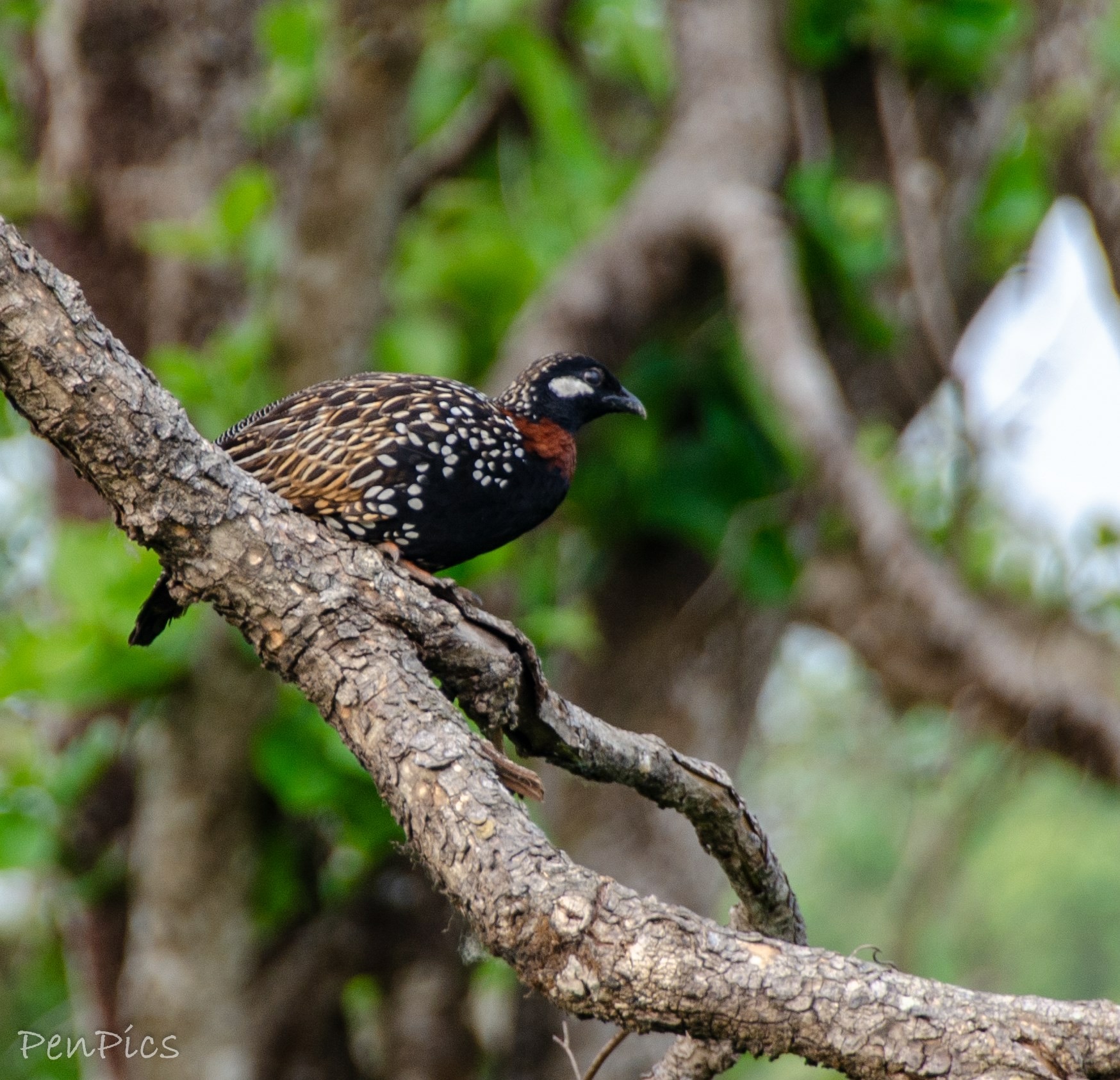
⬆️ The Bengal Florican Bird is on the verge of extinction, and yet, we did get to see one! That was a big deal!
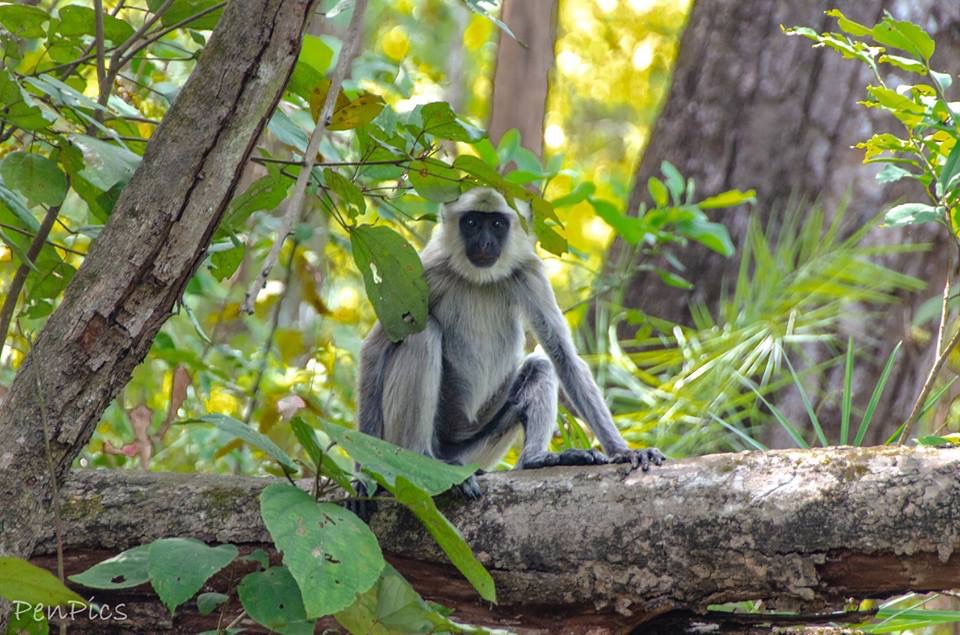
Lemur Monkeys Everywhere
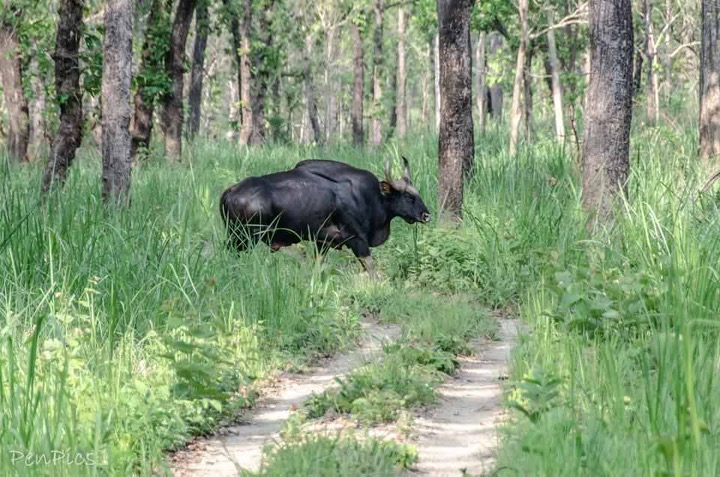
The Indian Bison. Look at the muscles on that guy!
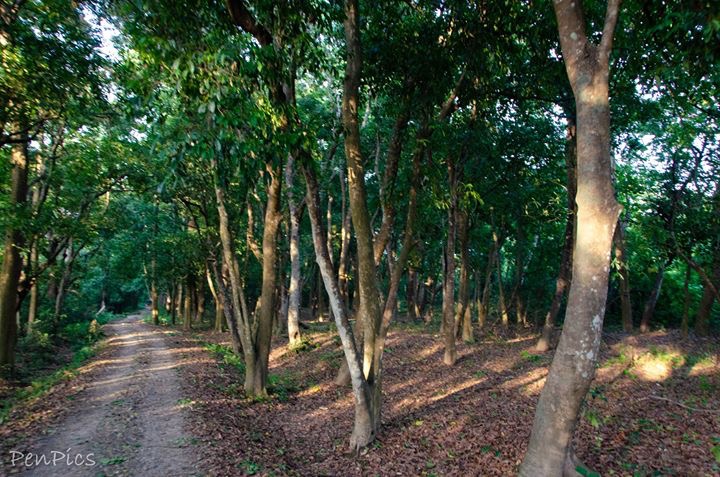
Just one; real, live, jungle scene in the Park; straight from the story books!
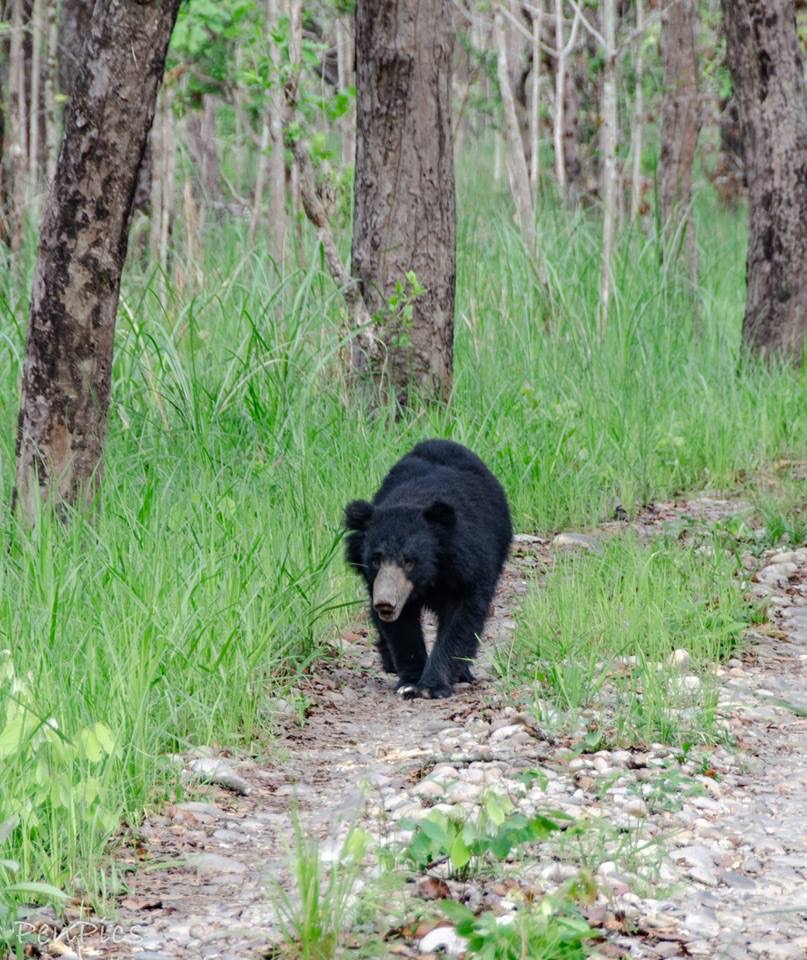
⬆️ The Indian Sun Bear

These people walking in the Chitwan park are most likely local village residents. There is one main road between villages, which is only open during the day; this main road borders the Chitwan interior Park. Only by permit, can the locals be on this road. Even with the road permit, that does not give them a pass into any other roads of the reserve. That being said, before Chitwan became a protected Safari Park, the local villagers lived inside the Park; now they live outside the Park. As a result, there are numerous fruit trees inside the reserve, from when the villages were still there. It is my understanding that villagers are allowed to enter and harvest fruits, but I do not know how often, or who gets to. The guy on the left ⬆️ (in the photo) is carrying a jackfruit. See the guy on the right ⬆️ carrying a long stick? This is a requirement to have on hand, to ward off wild animals such as Tigers, Leopards. and Rhinos, when walking in Chitwan.
What?
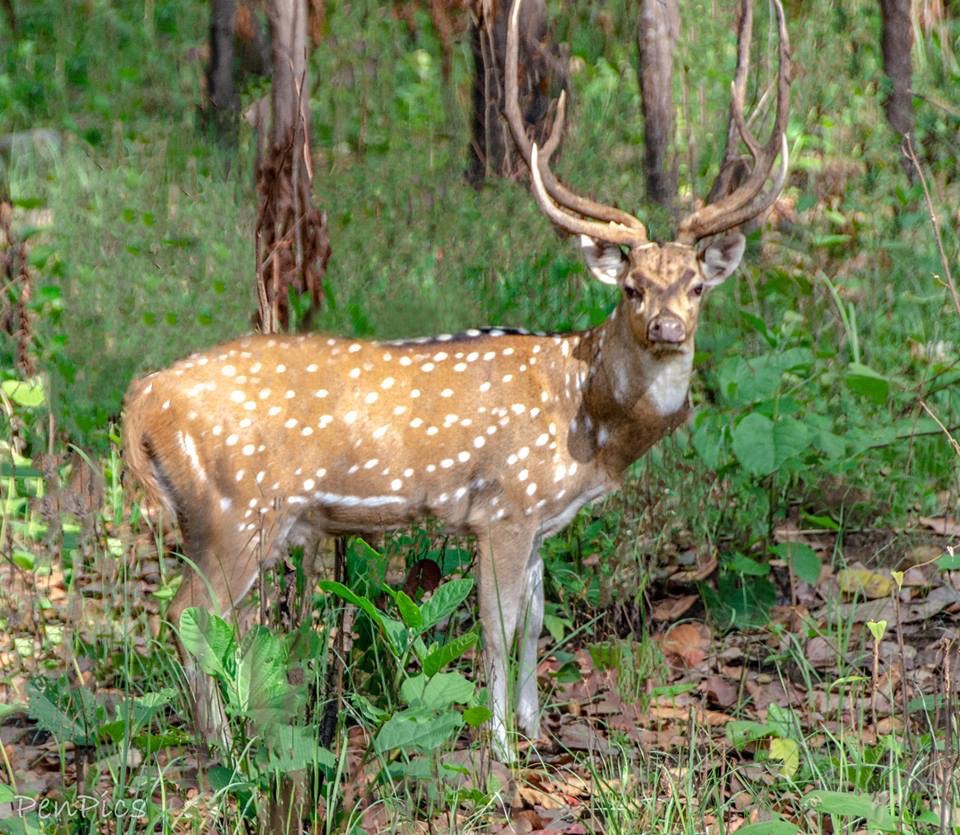
⬆️ Axis Deer
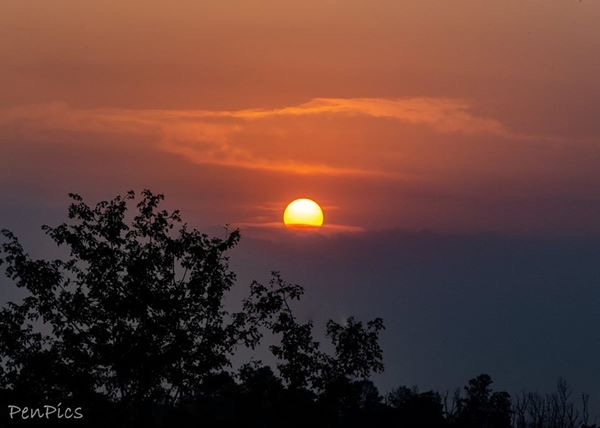
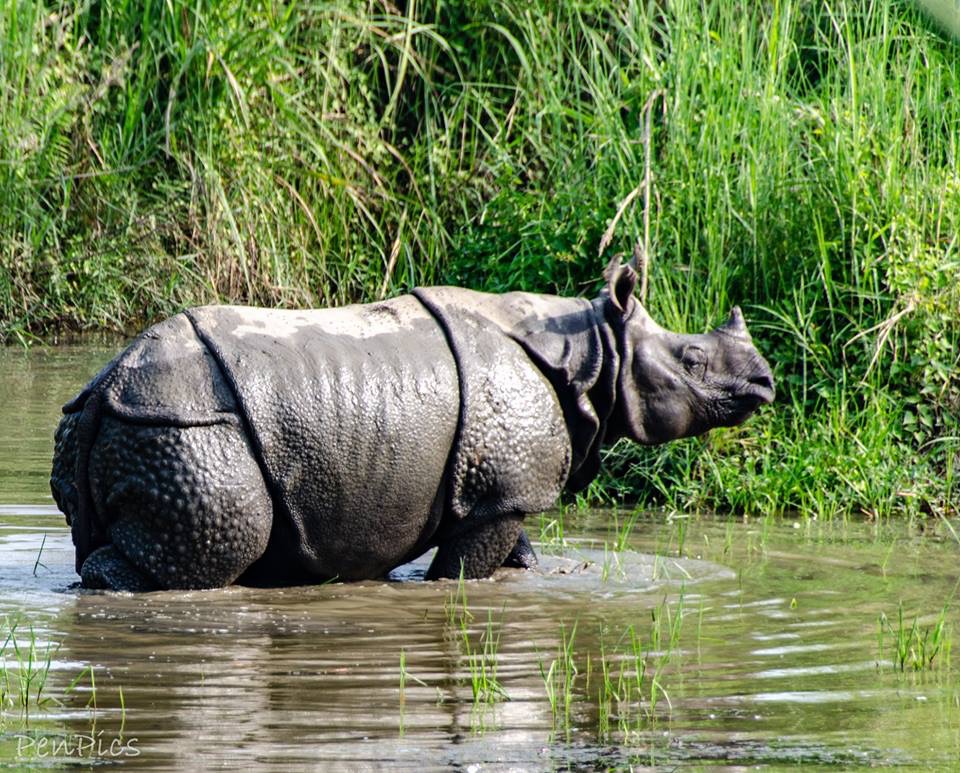
⬆️ The Short-Horned Rhino
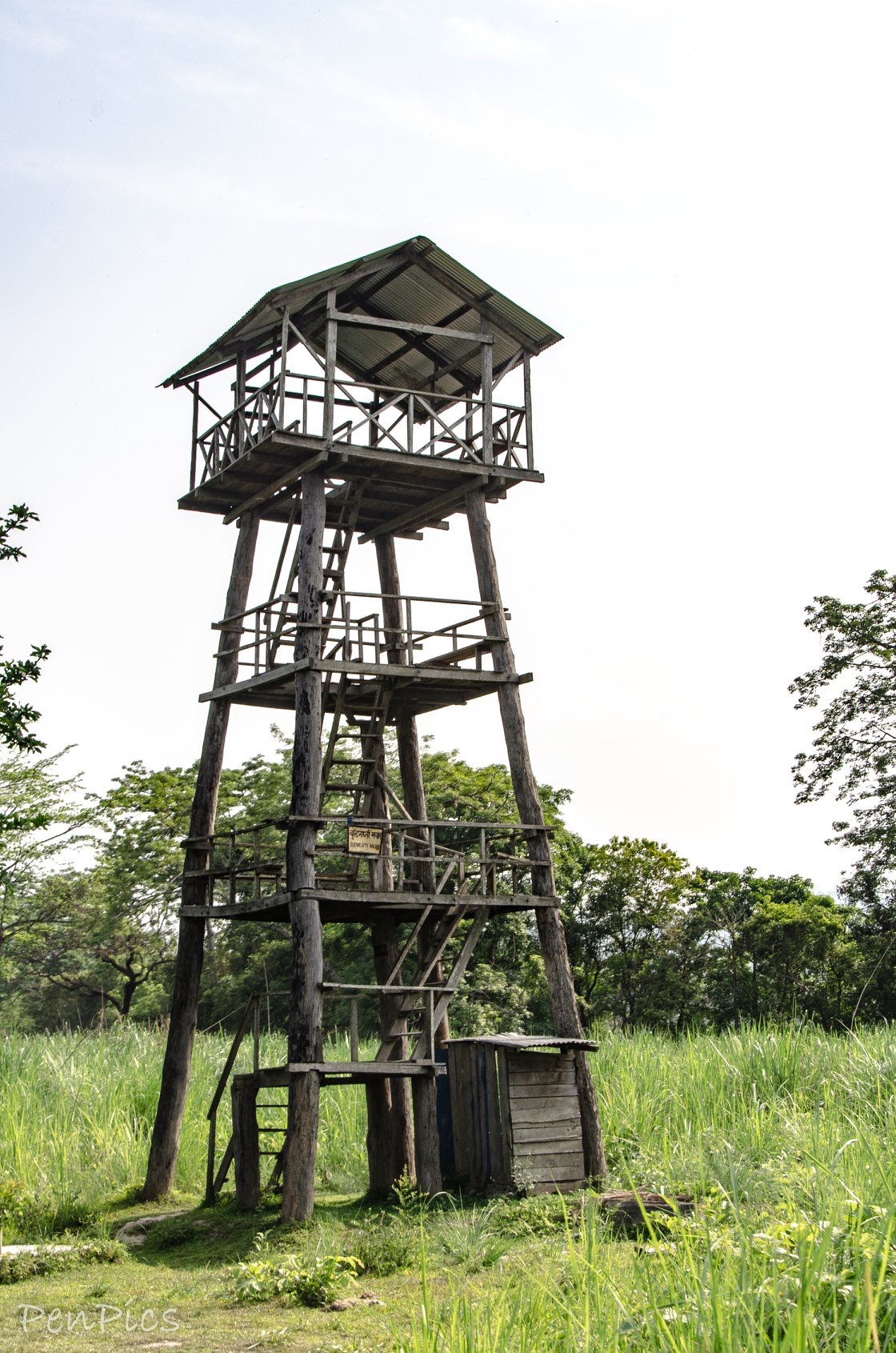

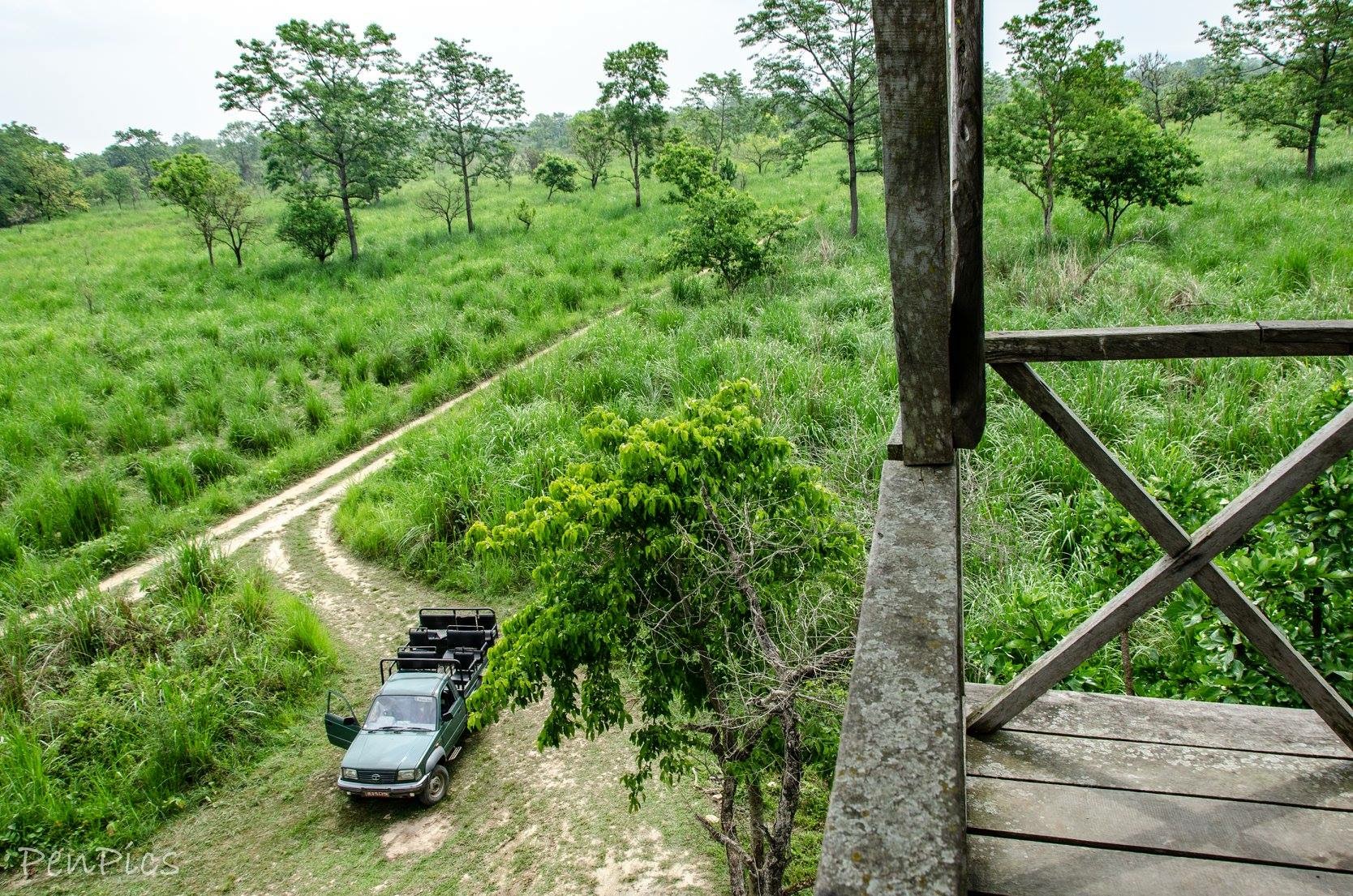
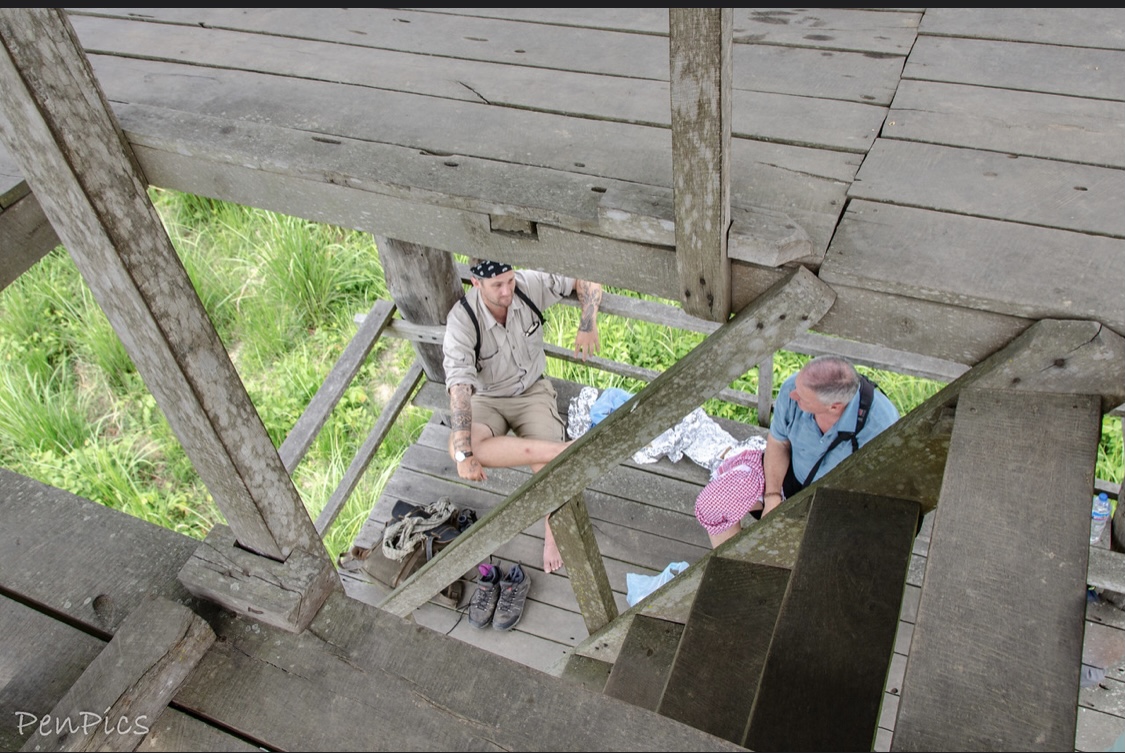
We would eat our breakfasts and lunches up on platforms like this. It offered great viewing outside the jeep, where we would be safe.
History of the Nepalese Army Posts inside Chitwan
The Army posts were already there, before Chitwan became a National Park. As a result, once the Monarchy fell in Nepal, and the Army Posts were no longer used the same way (as in fighting the civil war), the Army stepped in to protect the Park and its wild animals. They have done a terrific job, as there is no poaching in Chitwan!
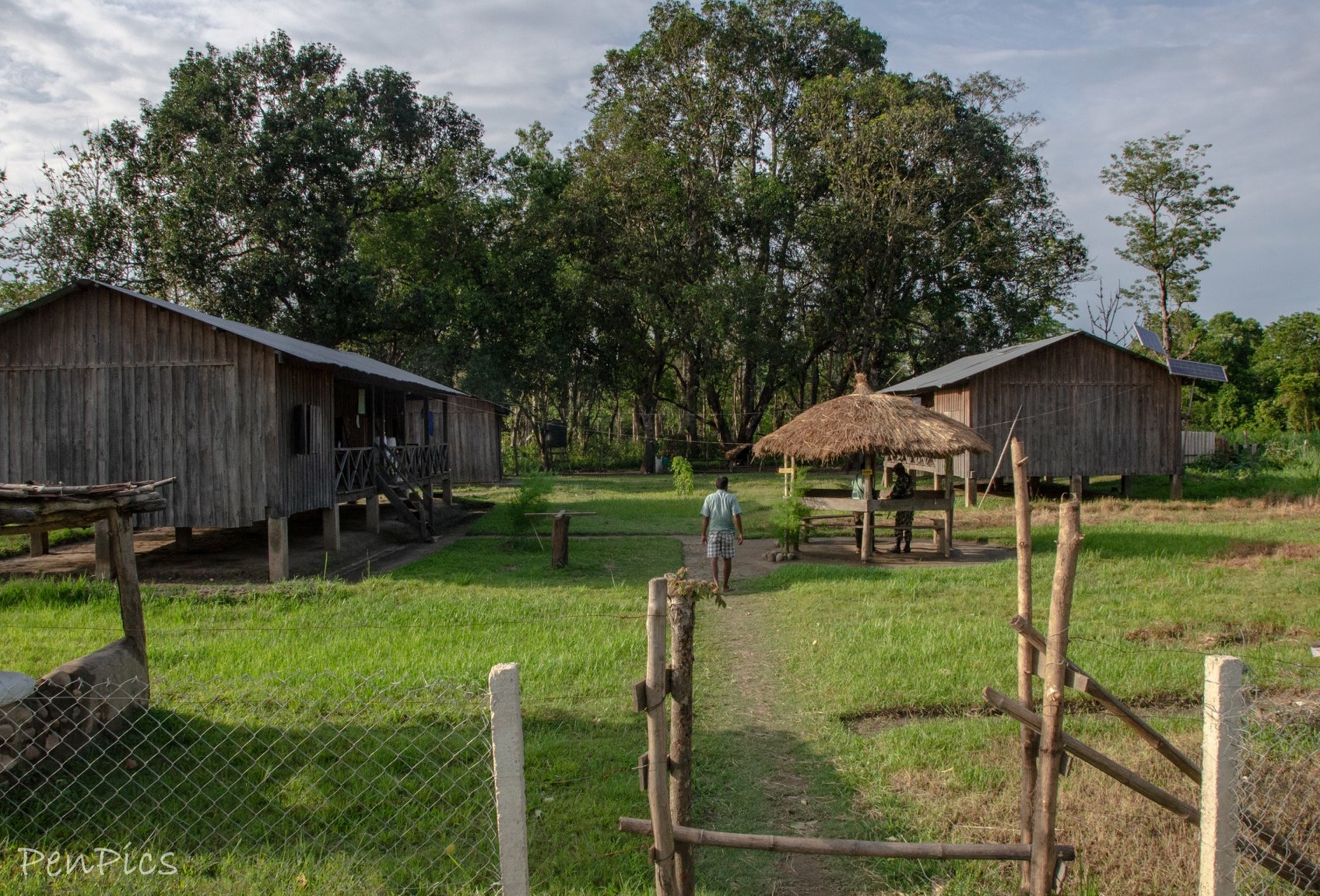
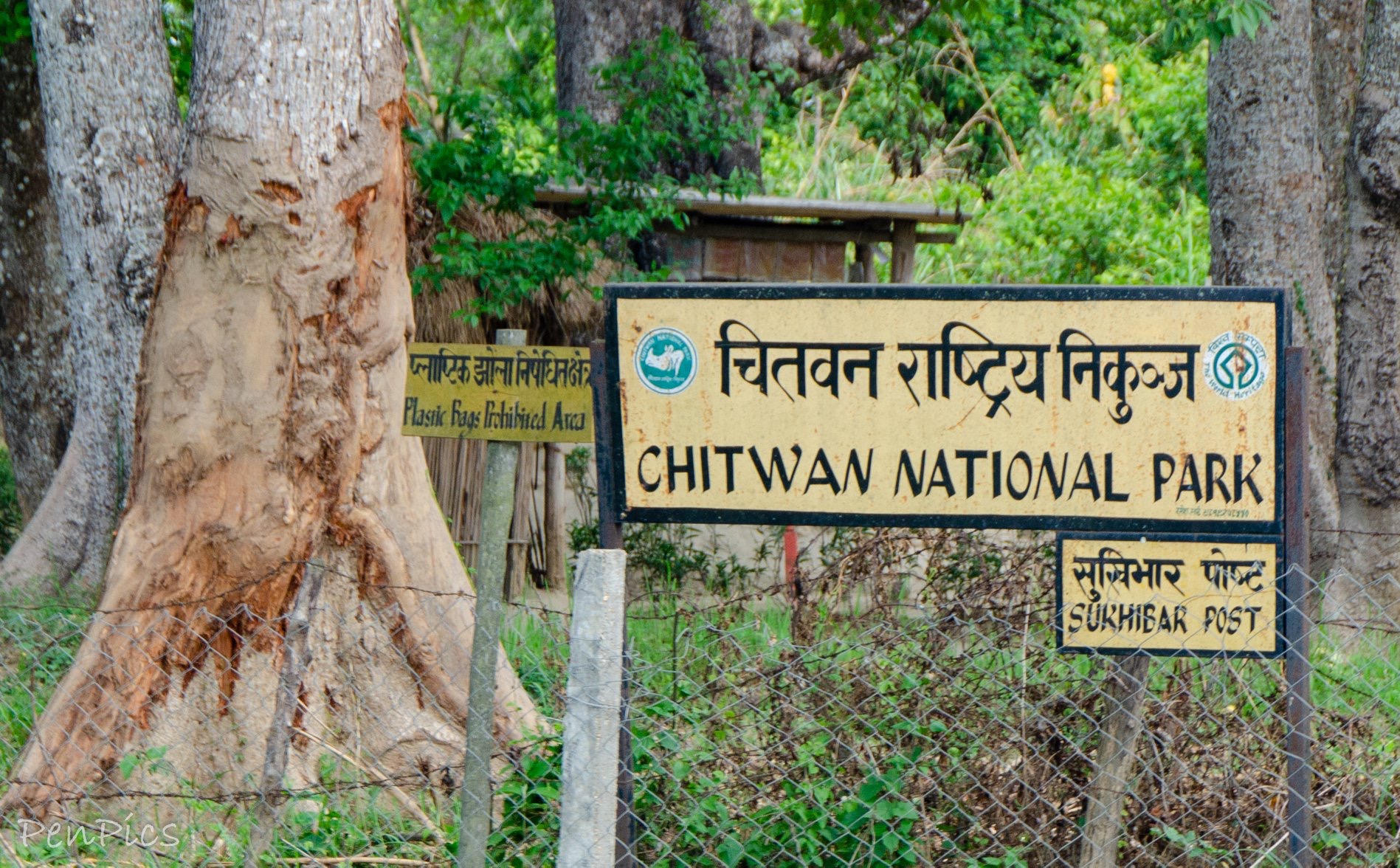
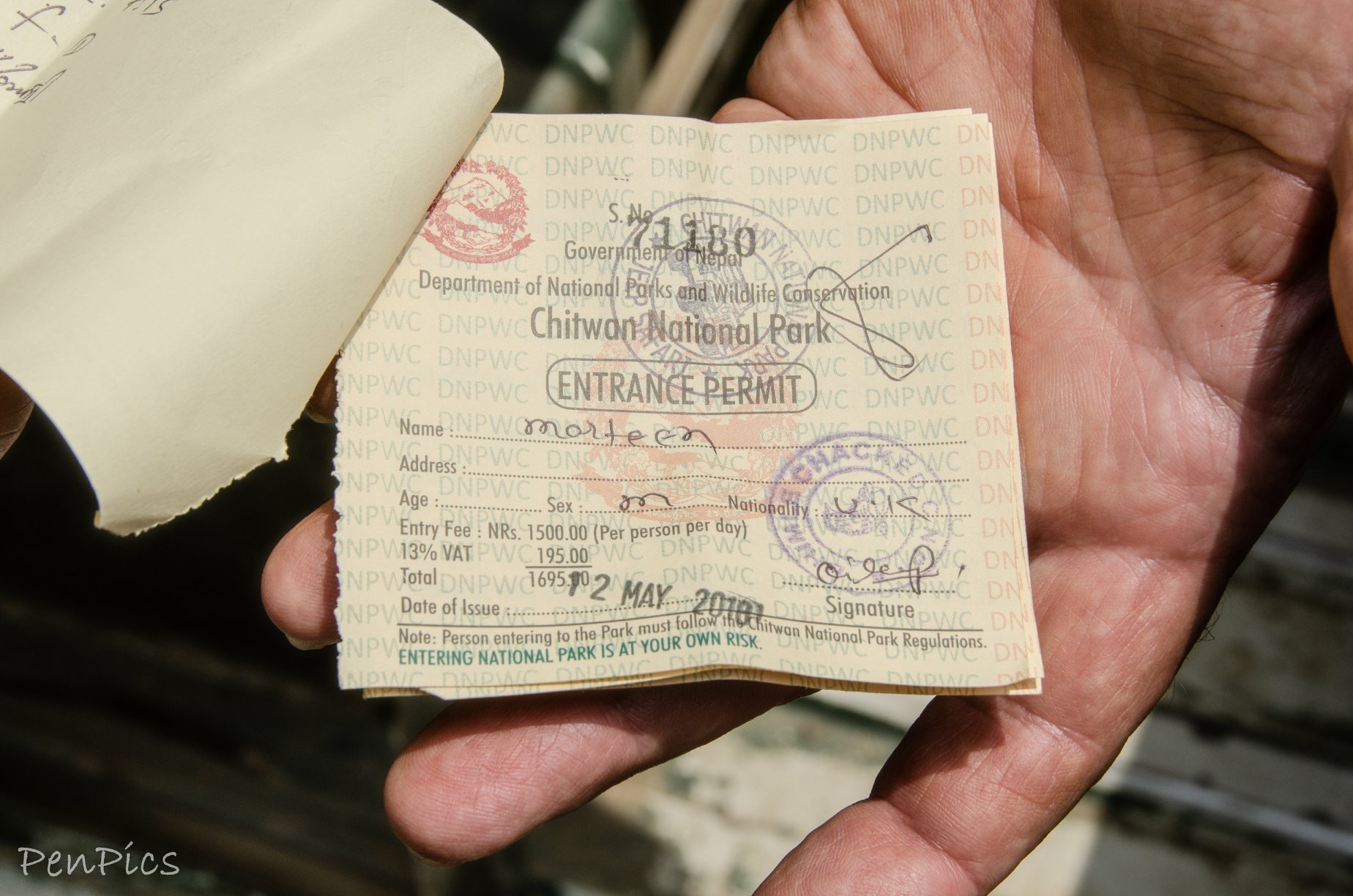
Daily Park Passes must be purchased, which allows permission to be in the Park. We stopped at many army post checkpoints, so the army could make sure we had permission to be inside the reserve. We purchased full-day passes, each day: 6AM to 6PM. Fines are issued, if late coming out of the Park at night.
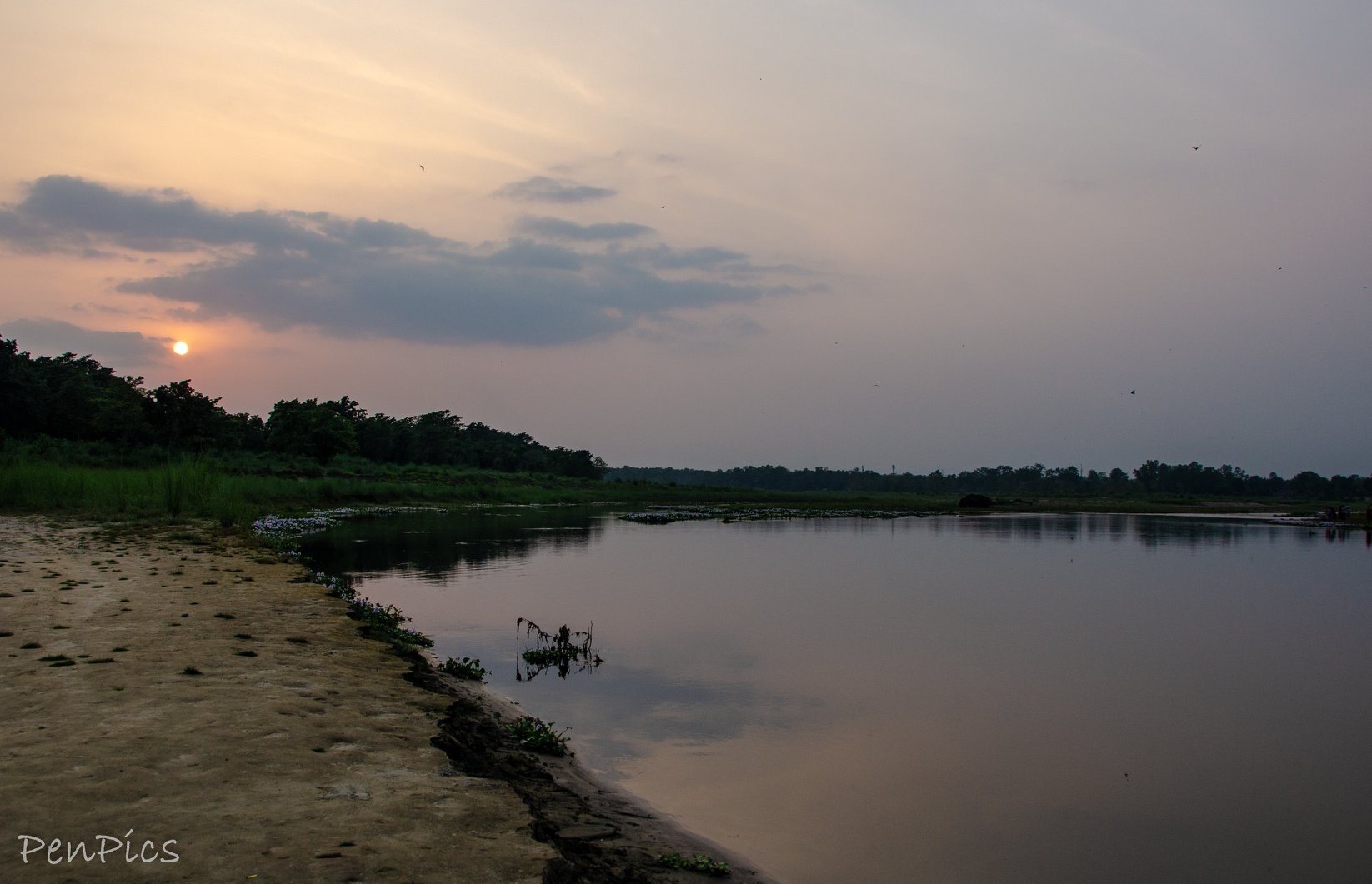
Here in the Chitwan National Forest, this same river runs along the mountain overplass; coming and going from Kathmandu. Its very long, and during the monsoon, it becomes very wide, and deep. During this time, fresh water dolphins come to live in Chitwan
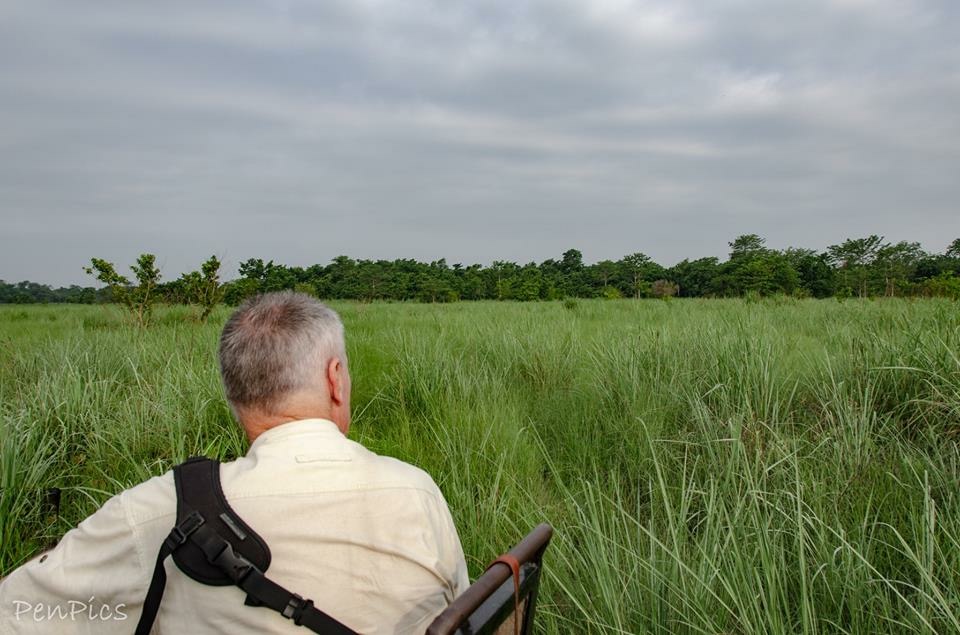
As you can see, the Elephant Grass makes great hiding places for the elusive Bengal Tiger. We are sure they saw us, though we did not see them!
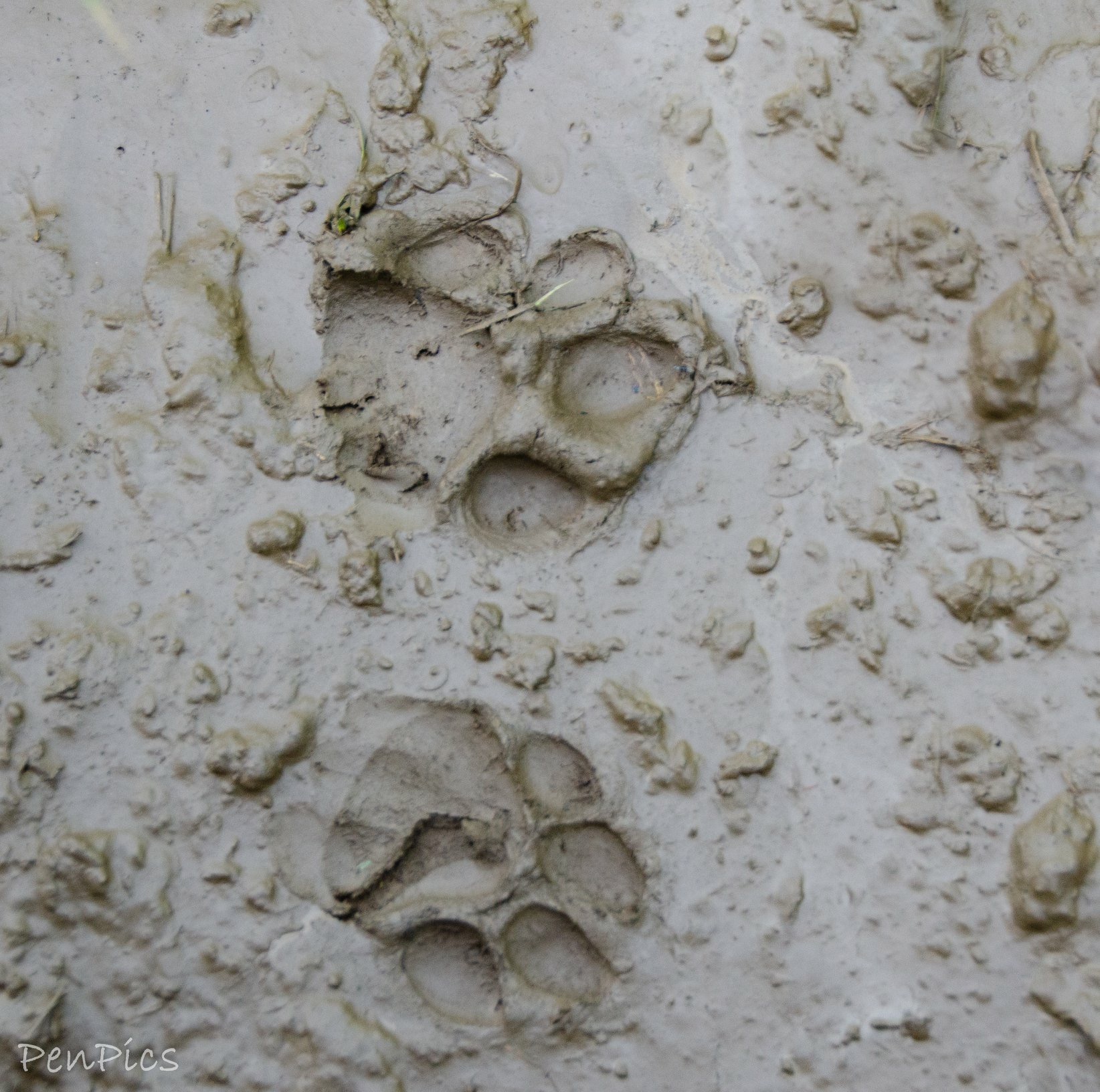
Cub Tiger Tracks
These prints were much smaller; next to the mama Tiger prints, seen below, These were cub prints. Prints like these (in a muddy patch in an otherwise very dry road) only are like this up to an hour at best; could have been five minutes shy of seeing the Tiger- or 50 minutes. No way of knowing for sure.
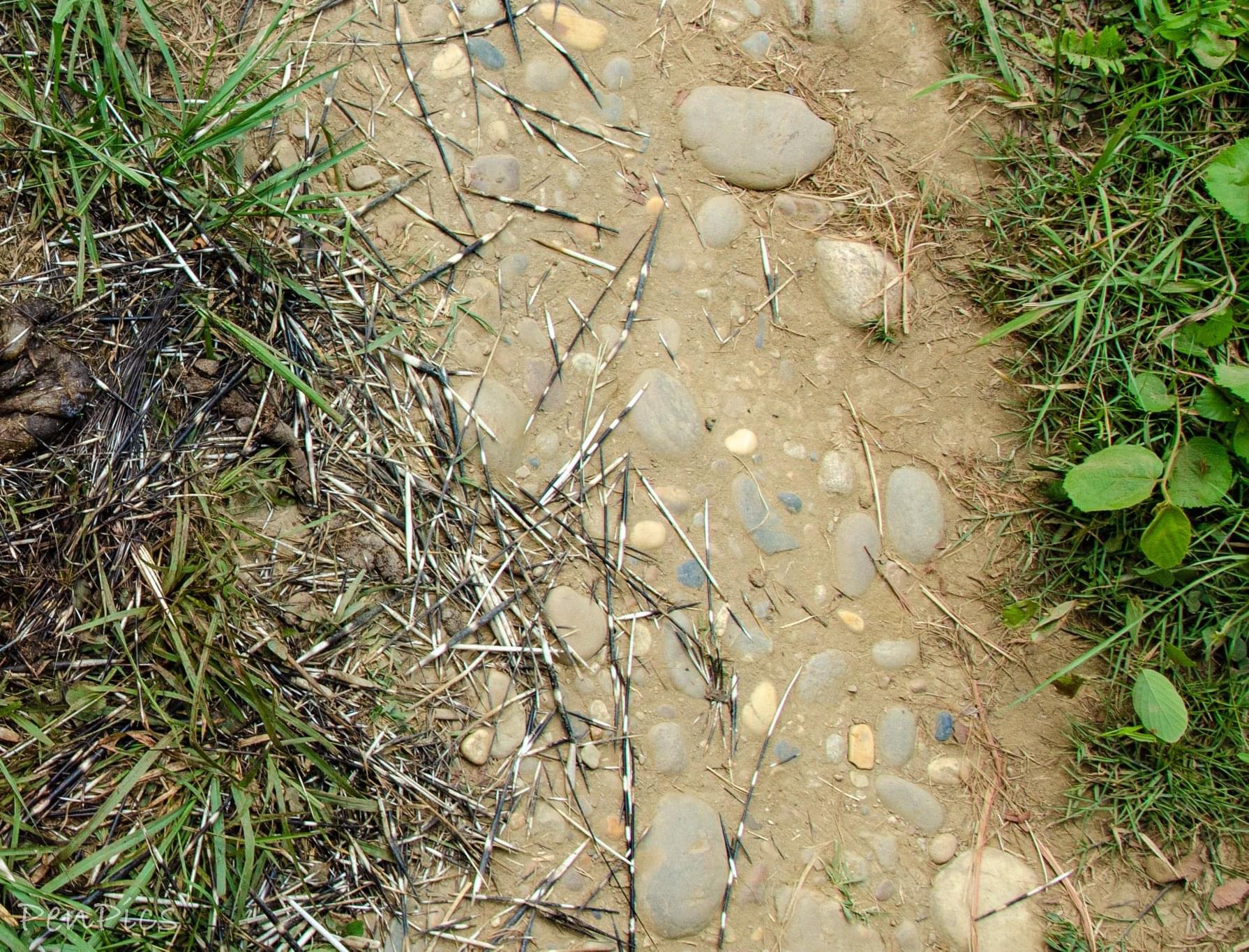
I spared you all the guts and glory of the indications of a Porcupine kill, ⬆️ but there are the quills. I jumped off the truck, quick like a Bunny, and grabbed a few souvenirs to take home! Our guide said the only two animals in the Park that are capable of killing a Porcupine are a Tiger and a Leopard. Since the Leopards and Tigers do NOT get along, they reside in different places in the Park. According to the CCTV camera, a Mama Tiger and her two cubs were on this road last night, so we think its was a Tiger kill.
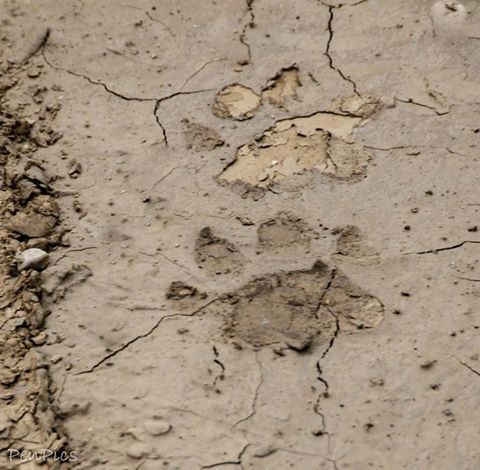
Adult Tiger Tracks
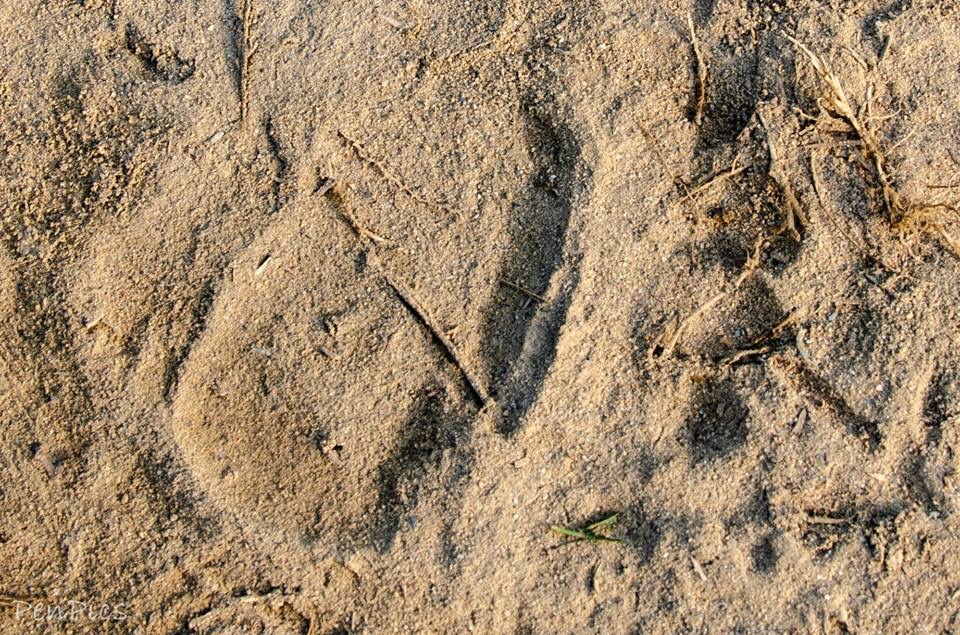
Sun Bear Track
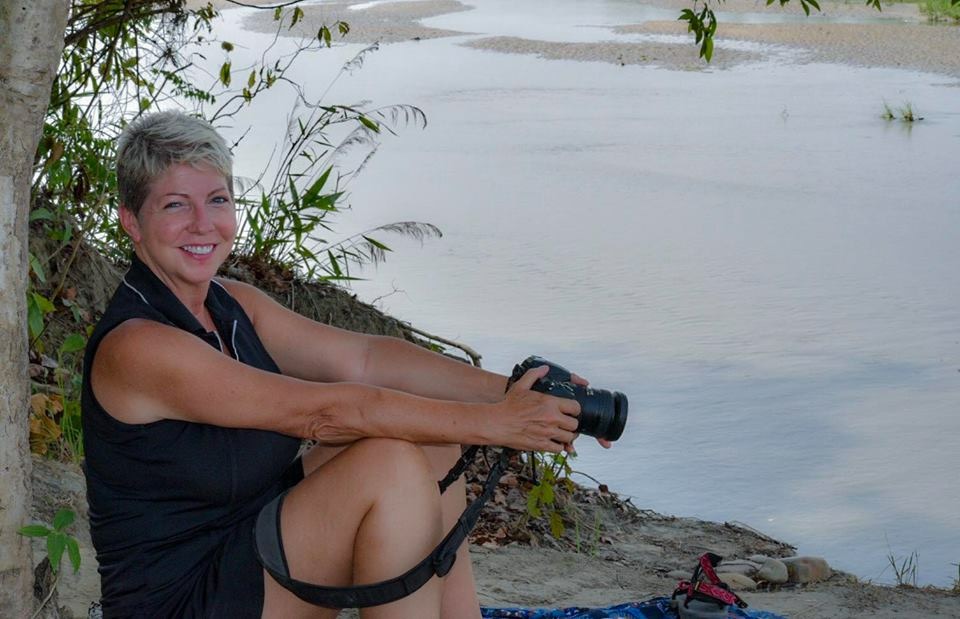
Outside the Jeep, in the shade, watching for Tigers to cross the River. No luck, but Chitwan is so beautiful, it was still wonderful.
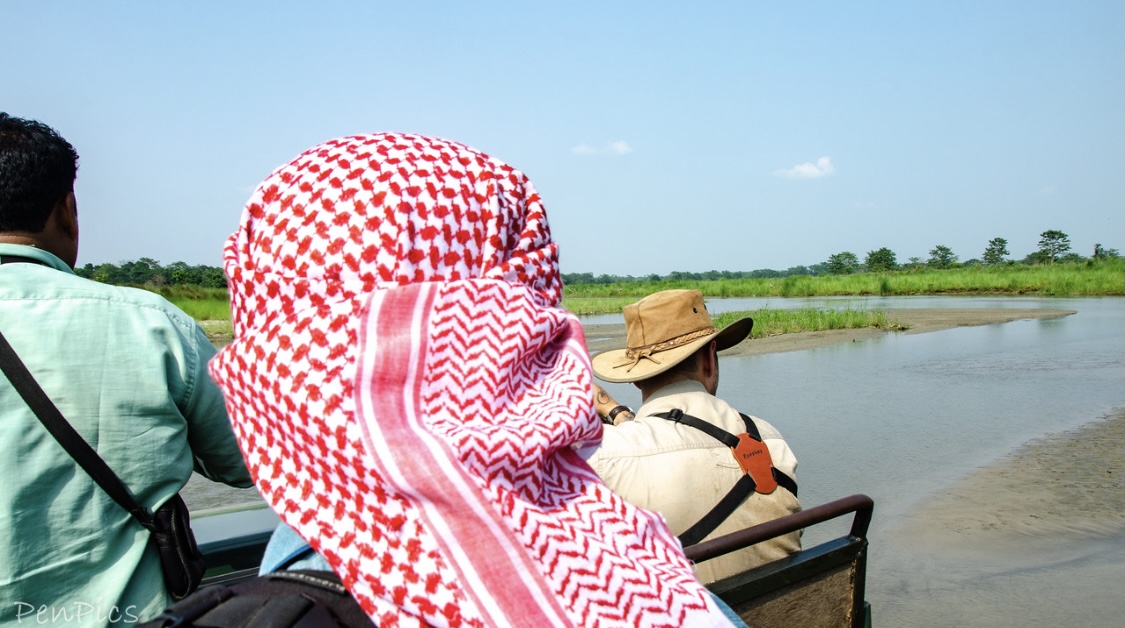
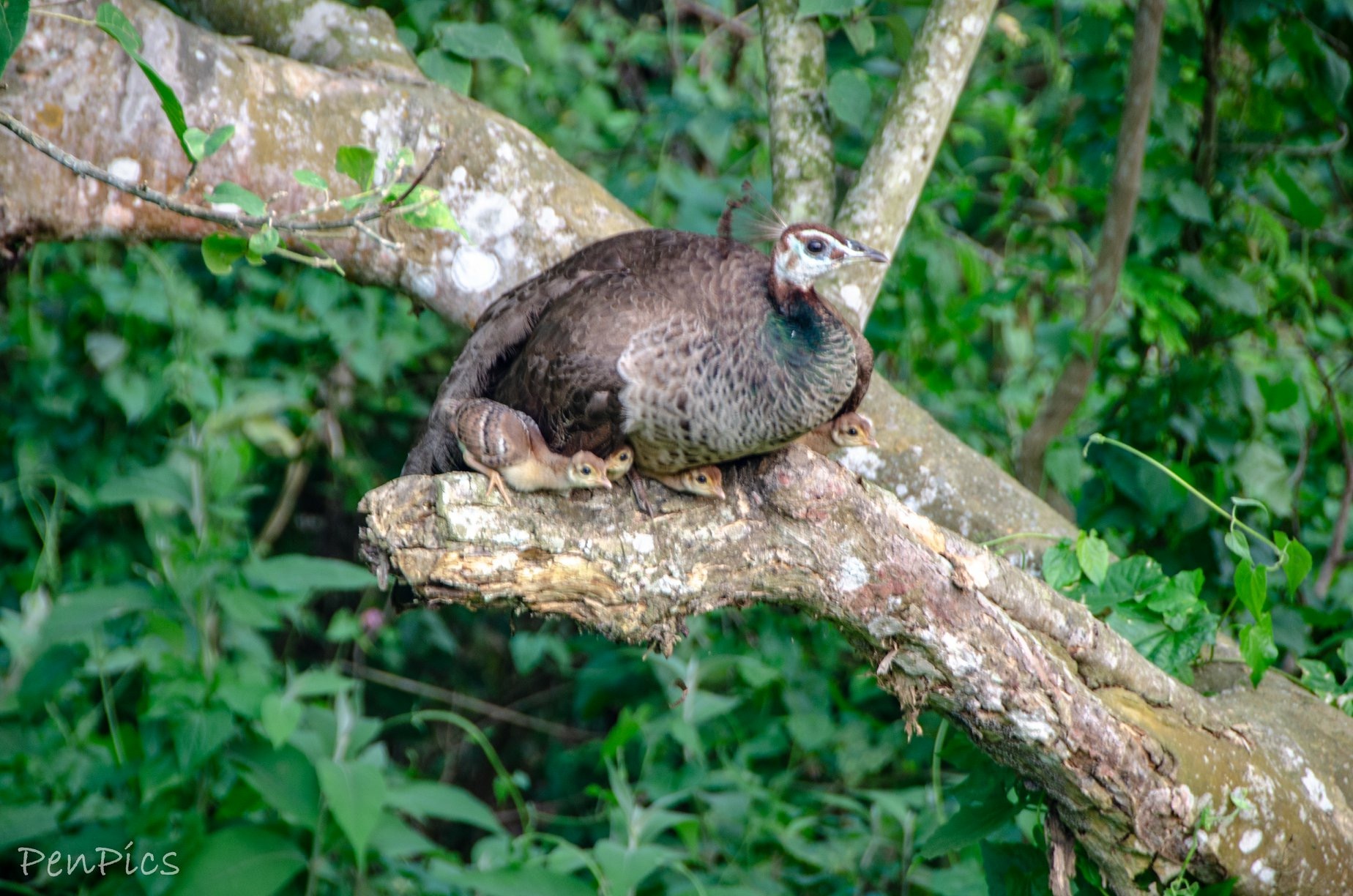
Mama Peacock and her brood
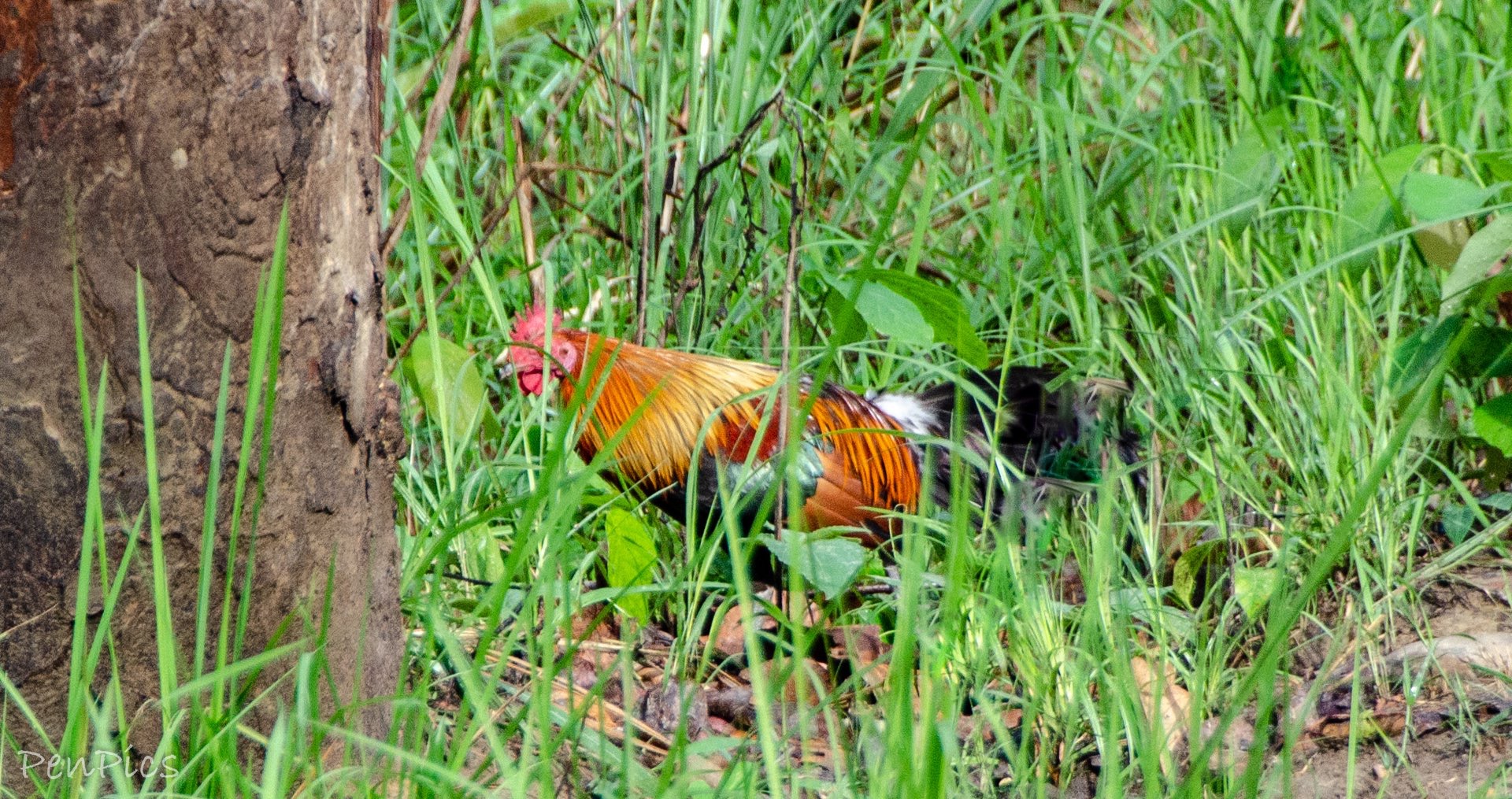
Did you know, chickens originated, right here in Chitwan? Every chicken in the world originated from Nepal. They still run wild in the Park.

Anti-Poaching Patrols are done from Ele back, bicycles, and on foot (with their sticks)
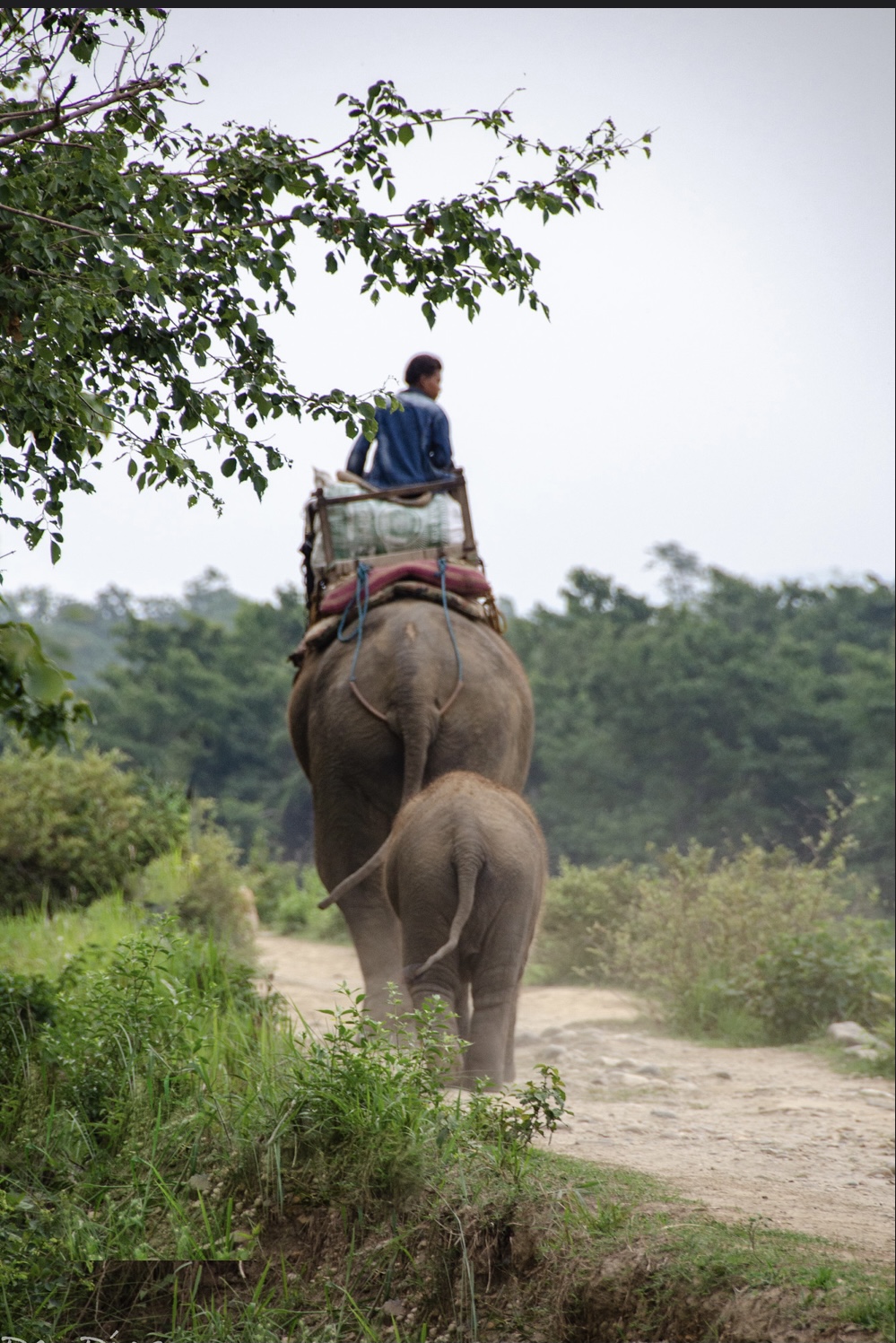
Baby Elephant in training

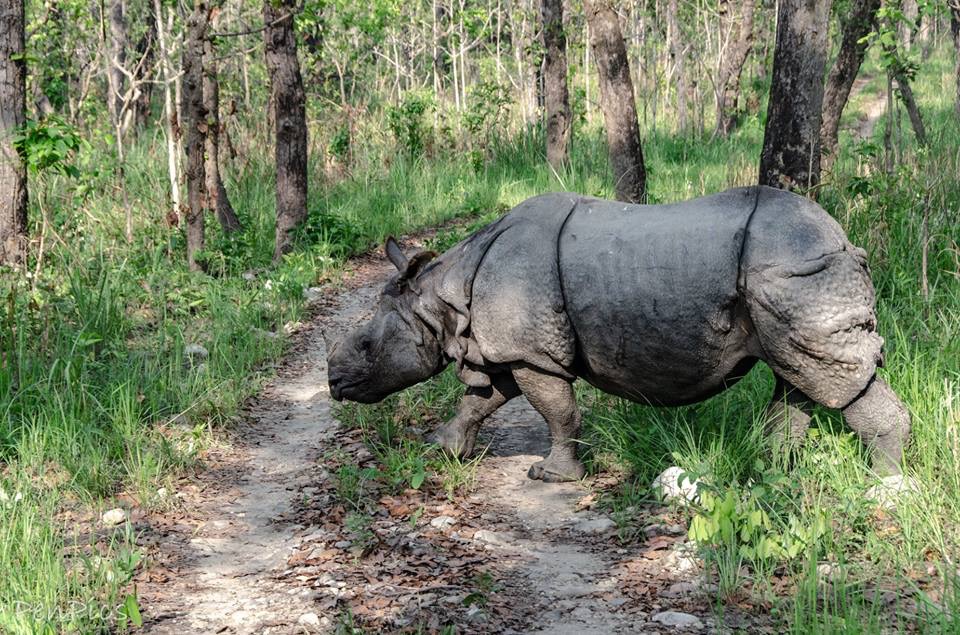
Walking Tours Are Allowed
The Park authorities do allow walking tours inside the park, during the day, on a specified route.
Anybody who chooses to walk through the Park has to have two guides, and carry the sticks.
Prior to the walking tour, they go to class and learn the emergency drills that would be used in the event of a wild animal attack.
For example, if charged by a Rhino, RUN to the nearest tree and climb fast. These Rhinos actually bite, not just gore. If there are no trees, then RUN in a zig-zag motion, as the Rhino does not see well, beyond six feet, and will literally follow you every step of the way to keep track of you; so as you zig and zag, the Rhino can not keep up, falls behind, and gives up.
An Elephant, however, sees very well, and as long as the Elephant has its eye on you, you are not safe. Again, climb the nearest tree very high, and if no climbing trees around, you must hide. The only way you will avoid an Elephant attack is if they stop “seeing” you. They will not give up, otherwise, and you will not survive. Find a place to hide (behind a tree is best) stay put and quiet. The Ele will think you are gone and will move on.
If a Tiger attacks you, the stick will not help. You will die.
End of class
NO, no thank you. Not interested in doing any walking tours in Chitwan. Yet, during our five days on Safari, we did see two small groups of foreigners, carrying their sticks. They were young adults who could probably climb trees very quickly if need be?
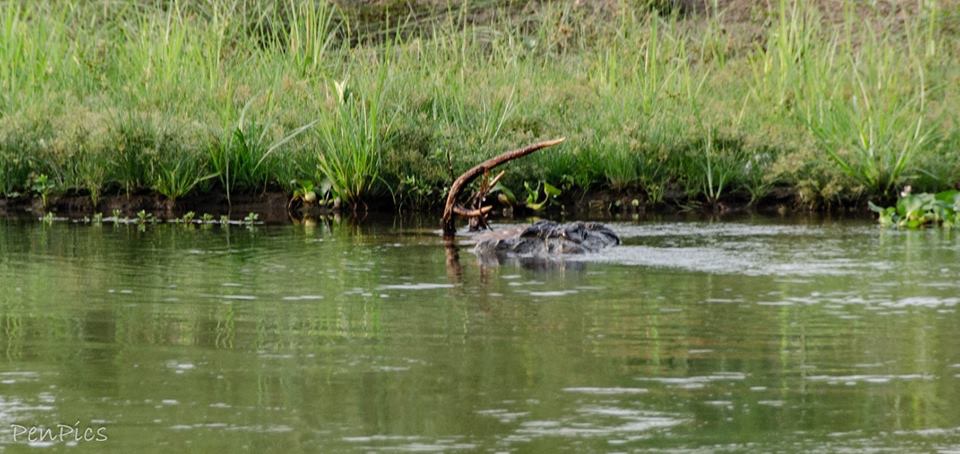
Early in the morning, while on Safari, we saw this Crocodile with a fresh kill in his jaws. The meal would be a huge Axis Deer.
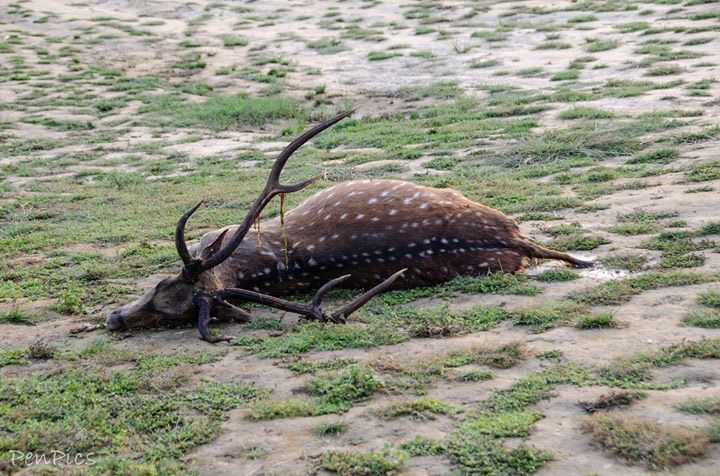
At the end of our day, when back at the river, we noticed the Axis Deer the Croc had killed earlier, was now on the banks of the river, instead of in the water where we saw it this morning; in the jaws of the Crocodile. (See photo ⬆️)
We learned the Deer was removed from the river, by the authorities, before the Croc could devour it. They had determined the Deer actually was killed by the Croc, and not by man. It’s something the enforcers do, to makes sure there is no poaching going on against any of the animals in the Park. They did give the Deer back to the Croc, and he ate it!
My Final Journal Entry 5/15/18
Today was our fifth, and final Safari day. My mind wants to keep going for more days, but my body says no. We are exhausted, but completely satisfied, and proud of our efforts to really “go for it,” under extremely hot and humid conditions, day after day; 12 hour days, in a rough-riding jeep, in this beautiful part of the world! Though we did not get to actually see the Tiger, we did have many exciting moments, as we got VERY close to two different Tigers. One of the Tigers had cubs with her, and we saw cub prints too! We know this to be true, because a few of the Checkpoints have animal cams, and the military would tell out driver, what they would see on the cams. I learned a little about tracking a Tiger as we Safari-ed, so I got a great deal of pleasure out of the “hunt.” One day I will see a Tiger in the wild, but not on this trip.
Though there are 120 Tigers in Chitwan (Nepal) the road systems are limited. They do not allow access to the whole Park, so the amount of actual Tigers we are trying to see (for their territory they keep) is only about four or five. This reduces the chances of an actual sighting, drastically. Luck has a lot to do with seeing the Tiger here, or anywhere. It’s the “Right Place-Right Time” kind of thing. In addition, Chitwan (Nepal) does have the largest saturation of wild Tigers anywhere, that is available to people on Safari. I was surprised to learn this. So, if you can’t see them here, then where? The India side of Chitwan, as well as other India reserves, perhaps. BUT, one of the reasons we avoided searching for a wild Tiger in India, is because we were told by our zoologist we hired for tracking, the experience would not be a peaceful and pleasant one like Nepal. The Indian people honk their horns EVERYWHERE they go, he told us. Having been to India, we certainly know about the honking. I couldn’t imagine it, inside a reserve. But, I never say never, because, perhaps, we will look into a short visit on a reserve in India (not necessary Chitwan, as they have more choices in India); as we plan to return to India next year to do the central and southern part.
UPDATE: We did choose India for our very successful Tiger Safari. Guess what? They do NOT honk horns in the reserve. The zoologist lied. He probably just wanted the job (he was from England). Oh well, live and learn.
Here are a few highlights from our Chitwan Safari:
1. We did see a most endangered Bird in the world; the Bengal Florican.
2. I got to see a Leopard, (for a few seconds only) just as it was going to cross the road–but when we came along, it slinked back into the grass. This took place the first 15 minutes on our first day. No other Leopard sightings had been experienced during our time in the Park.
3. We did get to see three wild Elephants (one baby) on our last day (these were the only three elephants that have been in the area; seen from the road system through the Park in quite awhile). This time of the year, the sugarcane is ripe and the herds were in the mountains enjoying their treat. We got charged by one of the adult Elephant (we did not provoke–just drove on the road).
4. We got charged another time by a mother Rhino, (again, unprovoked). AND lived to tell the tale.
5. We also saw Rhino breeding behavior in the wild. The females run from the male, so he has to chase her (in ridiculously hot and humid conditions). If he can keep up, and doesn’t die from exhaustion, he passes the test; the test being his DNA must be strong, meaning he can produce healthy babies.
Yes, I would say we had quite an adventure, with memories and photos that will last a lifetime!
Chitwan is very truly the most wild of the wild Safari reserves. If there are other reserves in the world quite like this, I do not know of any. I’ve been to six major reserves in Africa, as well as one private reserve, there. None of them are like Chitwan.
The inspiration for stories of “The Jungle Book,” and any Tarzan movie, or Disney themed attraction, came out of this jungle. It is that amazing to explore and experience! As much as I missed seeing herds of wild Elephants on this Safari, one of the reasons this reserve is so beautiful, is because there are very few elephants that are residing here. Elephants are VERY destructive to their environment, and food source. They are big, and powerful, so if they want to pull up a tree to eat the roots, they do not hesitate to do so! The tree dies, and is left to turn brown and be ugly, forever. Kruger National Park, in South Africa, may have looked like Chitwan at one time, but the huge numbers of Elephants that live in Kruger is evident by the toppled, torn, stripped broken, crushed, and uprooted trees; left by the hungry Ele (or one entertaining itself–Eles in the musk destroy trees; just because). The only downed trees in Chitwan happen by storms, and only a few by Elephant. Yes, there are plenty of downed trees, but the number of big, live, healthy trees that create the lovely canopy design, and setting are what makes it truly breathtaking and picture-perfect. In Kruger, those big canopy stands of trees are long gone.
To see all the photos from our time in Chitwan, click the link and enjoy!
https://picsbypen.smugmug.com/Places/AsiaLife/Nepal/Chitwan-National-Park/Safari/
Here We Go Again!
Returning from our wonderful Chitwan National Park Safari, required another Overland-Mountain bus-ride, back to Kathmandu. It is a cheap mode of travel, versus a spendy plane ride. This was my fourth and Daryl’s fifth trip over and back. With the rains that have been happening recently, this made the mountain crossing very unstable. We had multiple delays, (a 9-hour ride-normally, 6). One particular time, while waiting in bumper to bumper lines on the narrow and rugged mountain pass, rocks came loose and flew down the mountain, hitting our bus; AND hitting right below my window! Fortunately they were not boulders, but they were the size of basketballs! I saw them coming and could do nothing but duck in my seat, away from the window. I felt like a sitting duck! We are done with this bus ride for a long time, but we would like to return to Chitwan again, one day. It is so worth another visit, but perhaps we will fly!
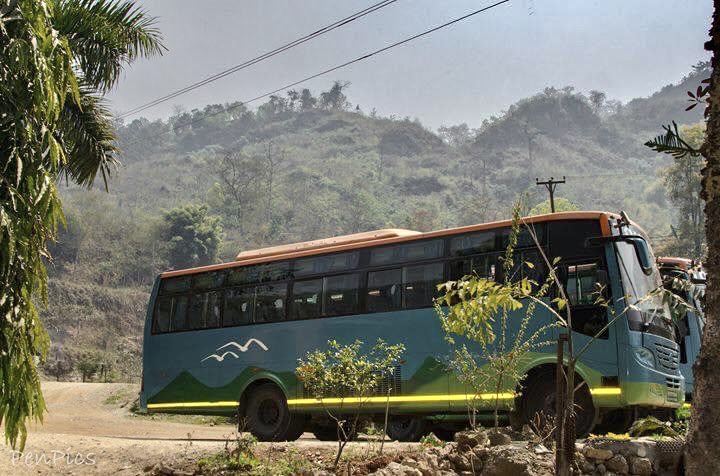
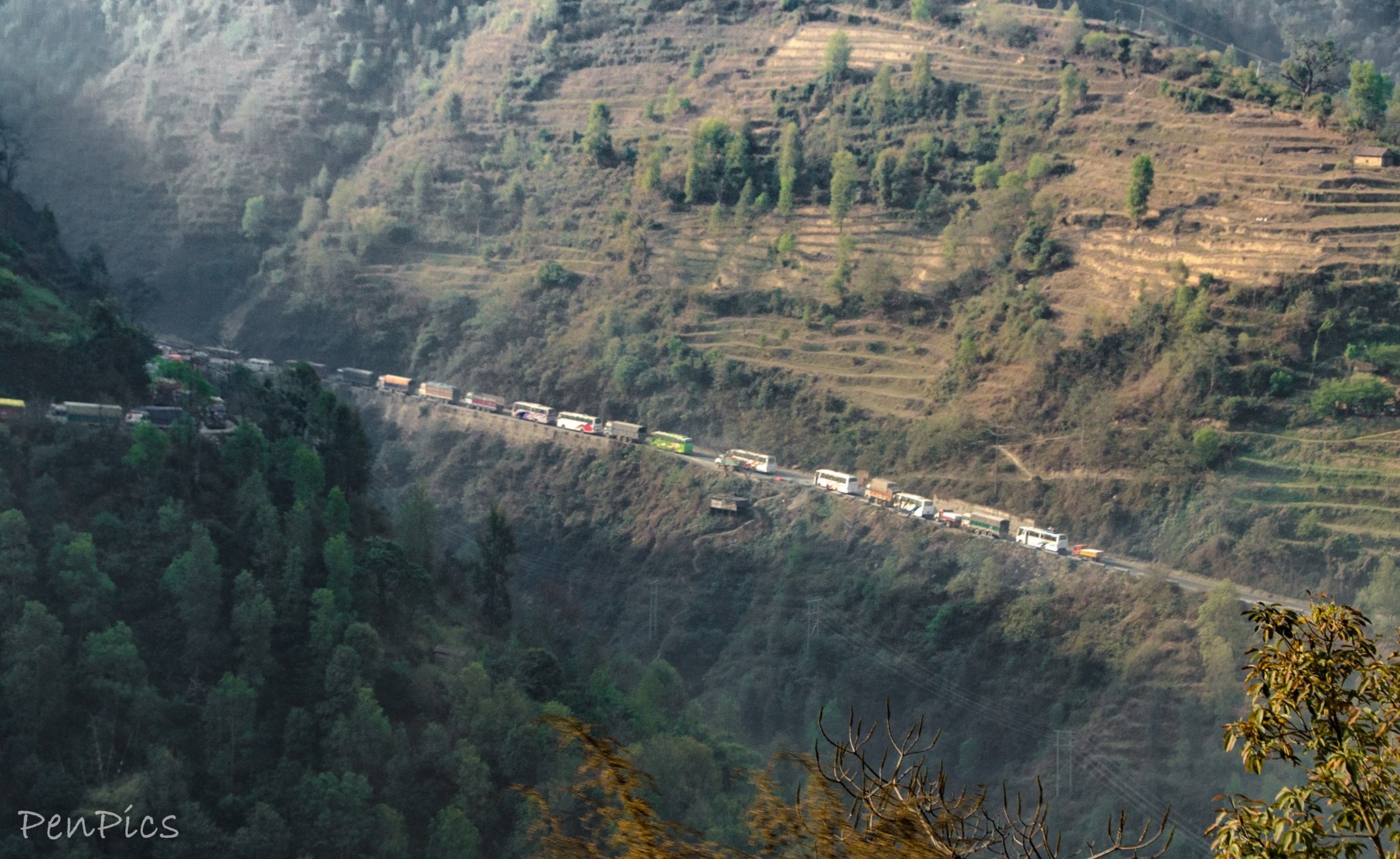
Following our final harrowing bus ride back to Kathmandu, we now must hang out, awaiting our approval from the Chinese Embassy to get permission to go to Tibet. We were told it would be about five days.
We have been to Kathmandu plenty of times, and if not for the need to get the Tibet Visa, and travel documents, we would not have returned. But, this is where a representative from Tibet resides, who helps arrange the proper paperwork for tourists, before flying to Tibet.
We love Kathmandu, but for starters, both Daryl and I suffer from “something” that is airborne here in “Dustmandu.” It is no coincidence that three times we have come and gone from here to do our adventuring, and each time have ended up with an upper respiratory infection. It does not gradually come on, either; it starts with throat irritation as soon as we arrive in the city from the outermost reaches. Yesterday, I dreaded the return, because I was all cleared up from the time in the beautiful Chitwan. The time before that we trekked in the clean mountain air of Annapurna. This time, I put my mask on before we hit Kathmandu! But masks, not being fully affective, I told Daryl I was not venturing “out in it,” except to eat and leave for the airport. To which proved most affective and I did not get the irritation. 🙃😜 This precaution, along with the recent rains, helped to settle that dust.
The Zoologist we hired for our Tiger-less Safari in Chitwan suggested that there may be a dust mite of sorts that we are highly reactive to. I believe it, because we do not normally get sick with anything. We also have spoken with many other foreign travelers who also get this dreaded affliction in Kathmandu. Ugh!
UPDATE: Today is our last day in Kathmandu. (Thank goodness) We have had (unavoidable) down-time, while we wait for the Embassy to approve our Visa and travel permit into Tibet. (We did watch “Seven Years in Tibet” on Netflix).
We have waited over a year to finally see Tibet! Tomorrow morning we fly. Yay!
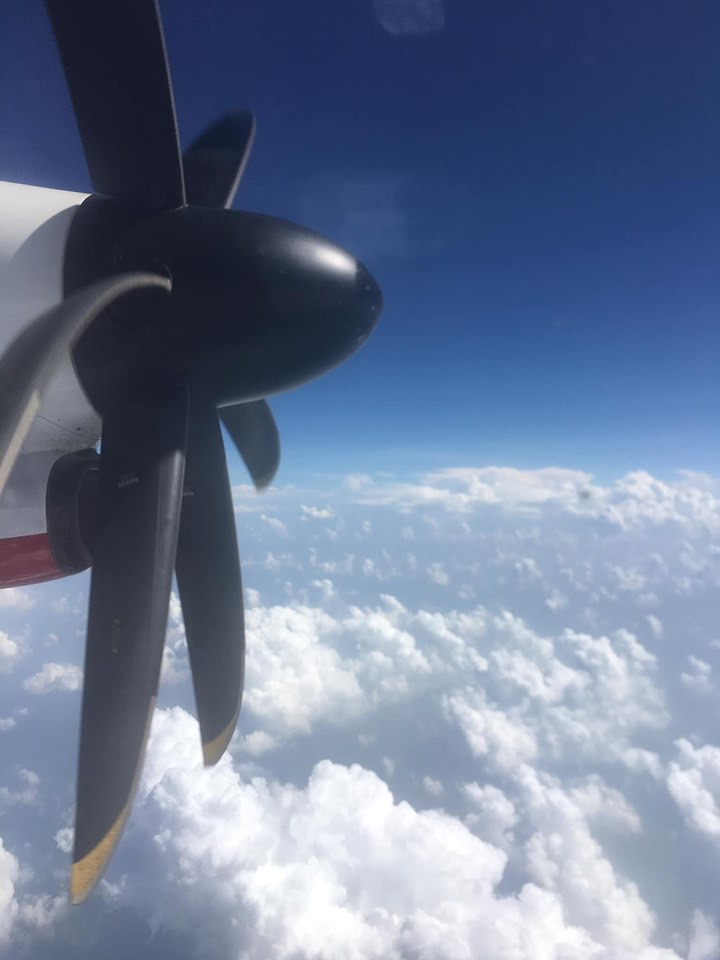
Archive Blog Posts of Our Country Visits
About Us

About Us
Hello and Welcome to our Travel Blog Website, We enjoy writing about our experiences and taking photos of our adventuring along the way. Our names are: Daryl and Pen, but Daryl calls me “Bunny.” We met, quite randomly, whilst both… Read More










